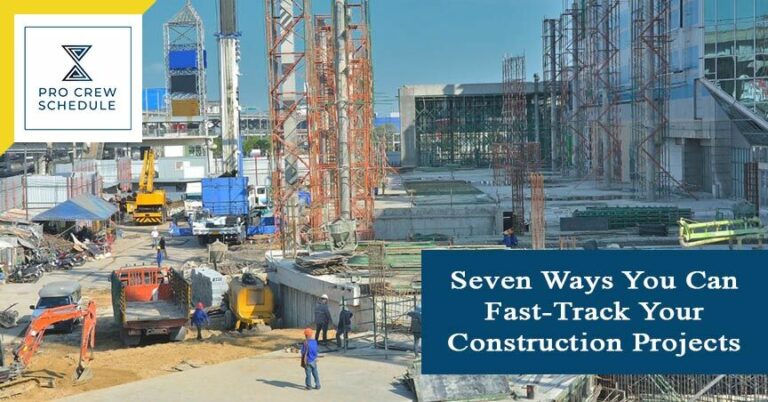When it comes to managing construction, you deal with a million moving parts that you need to keep track of to ensure the project is progressing according to the plan. No doubt, effective construction management is becoming an essential part of life for every successful general contractor. To meet all your deadlines and budget constraints, your construction crew has to be on point with everything they do.
Minor, everyday setbacks can cause project timelines, activity times, and budgets to go way over if not managed properly. In the long run, this can affect your project and your company’s reputation, profitability, and cash flows. As a result, fast-tracking general contracting projects are becoming more common in the industry. In this article, let us look at what fast-track construction project delivery is and strategies for how to implement it.
What is Fast-Track Construction Project Delivery?
Fast-track construction is a management strategy to start building the project even before the design is finished. The contractor is chosen early on and helps develop the design, and the work starts long before the design is done. As the building goes up, the designers try to keep up with the contractors. If everything goes well, the fast-track project should be done faster than a regular project. The primary goal of fast-track construction is to cut down on the time it takes to finish, which, if done right, can save a lot of money.
Construction schedules should be cut down on for reasons that may vary from client to client. Shorter schedules can lower the cost of building financing and running the organization designing and building, making it easier to hit time and budget constraints. The project can move along quickly because the design and building phases were done at the same time.
However, this is easier said than done. Getting a project done quickly through fast-track construction can take more work and effort to manage. A project manager needs to take the time to develop a deep understanding of the process, good planning, honesty, and close coordination between the groups doing the work.
Pros and Cons of a Fast-Track Construction Strategy
According to a study from the International Research Journal of Engineering and Technology entitled Strategies of Fast Track Mode of Construction, the main benefit of fast-track construction is that it saves both time and money. The overall design and building schedules are much shorter, allowing you to reduce the overall schedule and save a lot of money and labor expenses. The success of a fast-track delivery project comes down to how well contractors and clients work together and talk to each other.
However, general contractors or project managers must prioritize communication and collaboration between their teams. Fast-tracking projects can only succeed if communication between clients, contractors, and designers is broken or not as good as it could be. This makes it hard to finish a project well. Poor execution can cause costs to go up, relationships to get tense, and schedules to slip. Architects and engineers face more risks because there is no time between when the design is finished and when construction begins, and this means they need more time to find and fix problems.
Another con for fast-track construction is keeping a consistent design when work is done quickly or out of order. This may be harder since a fast-track project may need more change orders than a project done the old way. This cost is balanced by the savings made elsewhere in the process. Luckily, you can remedy this by using technology, such as construction management software, to keep track of everything and get access to updated information.
Tips on How You Can Make the Fast-Track Construction Work for Your Organization
Overall, a fast-track project can go smoothly and make money if everyone knows how it works from the start, stays in touch with each other throughout the project, starts with a firm contract and experienced contractors, and knows how important it is to work as a team.
This section lets Your professional construction management team use three main methods to shorten the time it takes to finish your project and get it done faster.
Consider Using Prefabricated Parts and Materials
Sometimes, a general contractor or architect must set specifications that conform to a certain standard or requirement. This may take a lot of time to procure these items. Still, an excellent alternative to this is to use Prefabricated parts. These can reduce the time it takes to install them in the field. For example, if you want to save time, have a prefab shop bend the conduit or pre-install motion detectors if they are used with lights.
Using prefabricated parts, your construction crew can start your electrical or plumbing work early and limit their time to do one thing. Since you already have the specs, you will get started even before the parts arrive.
Ramp Up Your Construction Crew Management
When deadlines and budgets are tight, and you are working with a team of different construction managers or experts, like builders, architects, and construction crew, it is essential to have good construction crew management. It might be challenging to keep track of everything, especially when handling multiple projects simultaneously. Luckily you can use crew scheduling software which allows your team to stay on top of everything from work orders and estimates to safety rules, which can be a lifesaver.
There are so many project management software tools for the construction industry that can help you streamline and optimize processes. One tip is to stay away from programs that are too hard to set up and run without on-site help or that have a lot of bells and whistles.
Utilize Construction Technology
Most construction workers want something that will make their job easier and not make the building process harder. You can leverage construction technology to help you solve common problems that will, in the end, shorten the time it takes to do everyday tasks.
You can use mobile apps to keep track of construction work and information on the job site, like the equipment you rent, the hours your workers work, the progress made, and more. You can use construction time tracking software to track how long your teams finish a specific activity. This way, you can get valuable insights on how to support your team. Another technology you can use is a construction management app, which can help you send mobile forms from one user to another to get more information, get approvals, and finish tasks that need to be looked over by more than one person. This can streamline all your processes, reducing downtowns and the risk of delays.
Be Ready for Potential Delays and Roadblocks
Plan and think about what could go wrong with your work. Construction project management software can keep you from being caught off guard by things like bad weather, back-ordered supplies, or cost overruns on labor and materials, all of which can ruin your project’s success and your company’s reputation.
Prioritize Communication
With fast-track construction projects, employees and other partners who are off-site but still need to know what is going on need to be kept in the loop. Keep everyone interested in the project up to date on any changes or new information about it. Make sure that other people are giving you the information you need to do your part of the job well.
Construction scheduling software can be a big help here because it lets you share data and information about construction work with others in real-time. Since the data is stored in the cloud, there is only one “final” copy of each document, not multiple versions that could be outdated.
Go Paperless
Even though cloud computing and other technologies can help, many businesses in the construction industry still use old-fashioned paper forms to keep track of all their construction work, from ordering materials and making estimates to keeping track of labor, billing, and safety rules. It is best to use a cloud-based platform where you can upload your documents online for safekeeping. No more looking through countless file cabinets for a single document. This also reduces the risk of lost documents. You can route your files for signatories through software.
Use A Centralized Platform
All communication and information should be centralized and controlled.
From the beginning to the end of the project, a centralized platform allows you to ensure that important messages or tasks are seen and taken care of. As a result, this speeds up the project schedule and reduces the time you and your team spend answering questions. You can focus more on the critical parts of project management rather than the tedious, repetitive tasks.
As a project manager, you communicate with many teams – from your stakeholders, subcontractors, and other trade partners. Using an online or cloud-based platform means that you will not have to deal with the endless questions, emails, phone calls, and delays that come with them from architects, engineers, designers, and contractors.







